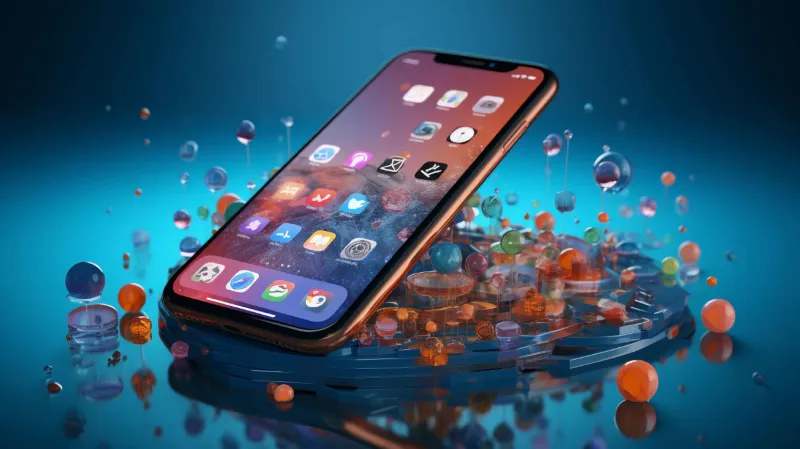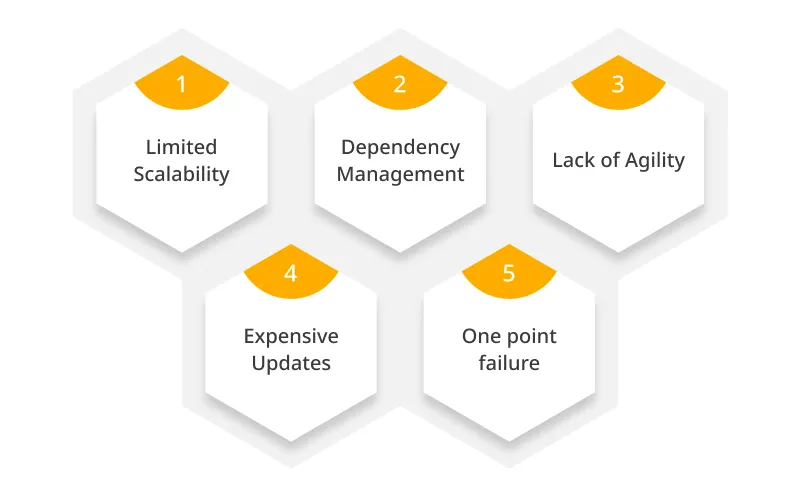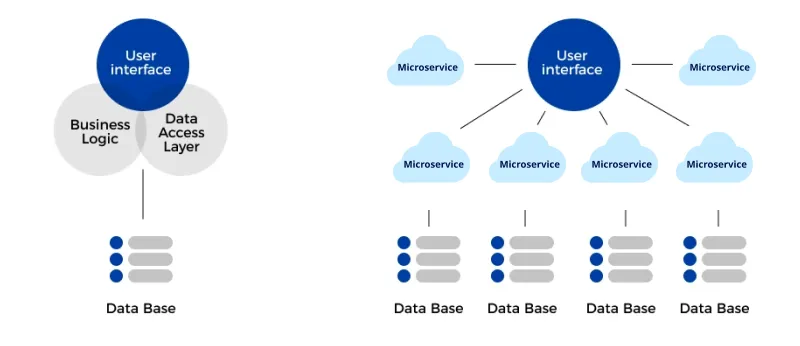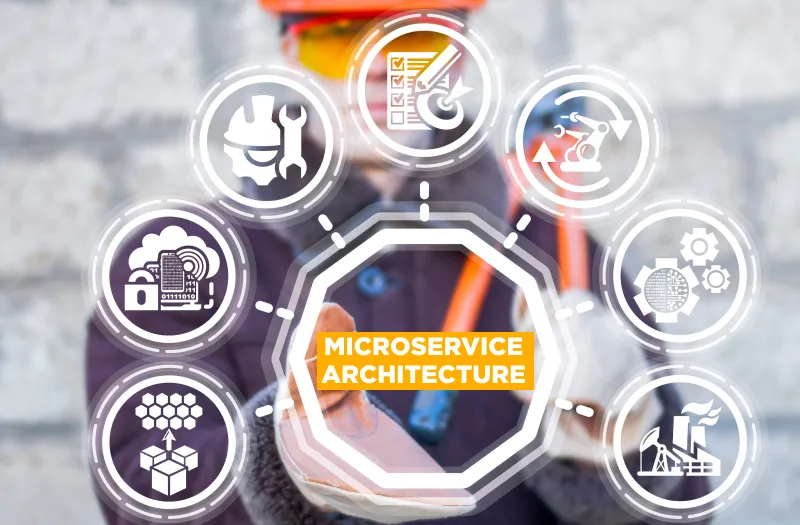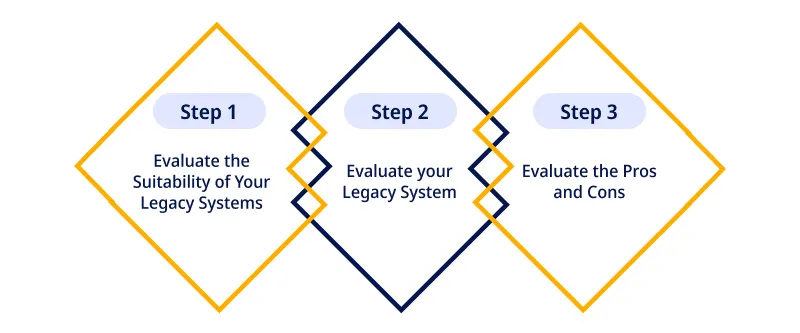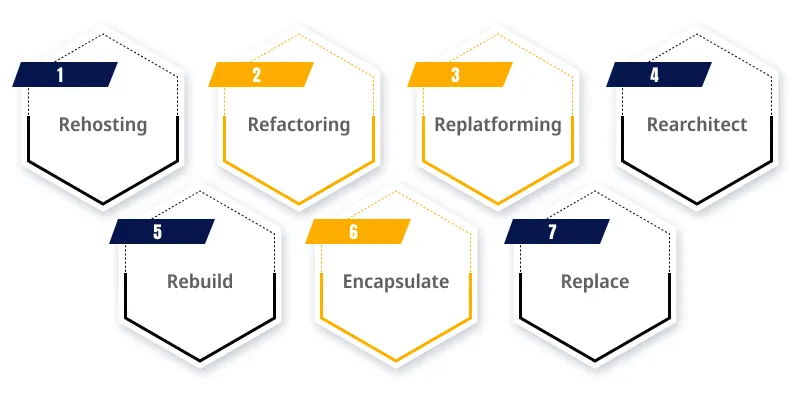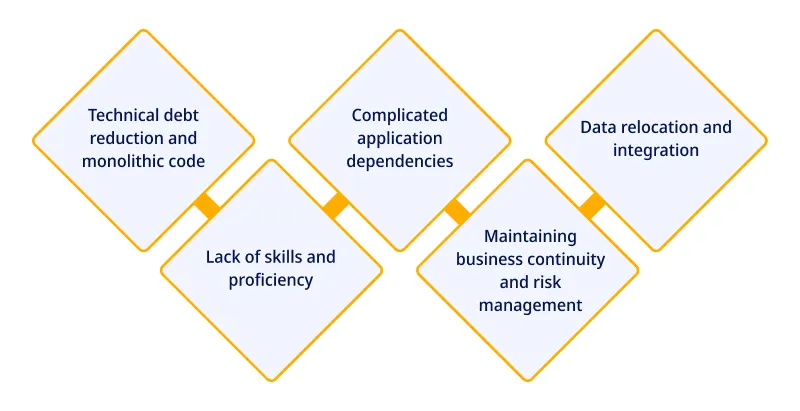The rapid advancement of market demands and the evolution of technologies are constantly putting pressure on businesses to modernize monolithic applications.
The existing old applications not only impact innovation and growth but also risk next-gen success for companies. This puts CIOs in the spotlight, showing their crucial role in ensuring smooth modern transitions and agile software development applications.
Gartner conducted a survey to understand the CIO’s agenda for 2024. According to the survey, 2,457 CIO respondents in 84 countries across major industries spent $12.5 trillion in revenue/public sector budgets and $163 billion in IT infrastructure optimization expenditures.
However, they often find it difficult to manage the challenges of dealing with legacy applications offering limited upgrade capability.
They may lack flexibility, which is crucial for upgrading with new features and scale in open-source and cloud environments.
ValueCoders has the expertise for modernizing monolithic applications using the best practices for businesses of all sizes. We are sharing the same through our this blog post.
Let’s look at the crucial steps for an effective transition to modernizing monolithic apps.
Monolithic Application – What is it?
A monolithic architecture application is a type of software in which all the app’s components and gatherings are interconnected and reliant on each other.
Simply put, the app is completely developed and deployed on a single unit, having all the coders and resources connected together.
In such applications, even a basic change for modernization can impact the overall application, which may further require a completed redeployment.
Before we move towards the steps of modernizing monolithic applications, let’s understand the challenges or flaws of legacy apps for modernization. It will help you make a better solution.
Utilize our cloud expertise to migrate your monolithic apps, unlocking cost-efficiency and flexibility.
Challenges of a Monolithic Application
Some of the common challenges faced in legacy systems having monolithic architecture include:
1. Limited Scalability
As we’ve already stated earlier, scaling legacy apps can be challenging as the business grows. Even a single change in any one part may impact the complete systems and require a complete application redeployment.
2. Dependency Management
A legacy system upgrade is also necessary because these apps have some dependencies between components. In most cases, managing and upgrading these dependencies can be troubling.
3. Lack of Agility
Legacy application migration and modernization are often slow to transform. This can impact businesses and make it complicated to meet changing market trends and dynamic user requirements quickly.
4. Expensive Updates
As we’ve already pointed out, every component is interconnected, therefore, even a single change may lead to redeployment. This can be a expensive process for businesses.
5. One-point failure
Another challenge that engineers face with monolithic legacy systems is one-point failure. This means a single glitch in one component may bring down everything available in the application, since all the components are interlinked to each other,
After reading all these challenges, are you feeling annoyed by these limitations with monolithic applications?
Don’t let these limitations impact your progress. Consult our enterprise software development services experts for modernizing monolithic applications.
Also Read: Top 10 Popular Apps Built With Flutter Framework
Understanding Application Modernization and the Cloud
Before we get into the details, let’s first understand what application modernization strategy is.
According to Cognizant, “Application modernization is the process of updating legacy applications to scalable, cloud-native app environments by using modern technology stacks. Through this process, applications can continue to meet modern user expectations as they evolve. “
If we break this definition, this basically includes two parts, the first is migration and the second is cloud.
Therefore, modernizing monolithic applications is majorly dependent on these two crucial components.
Migration is the process of moving an app from its existing environment to a new one, for instance cloud.
Whereas, the cloud is a group of remote resources or servers that can be accessed using the Internet. This offers a scalable and flexible infrastructure for accessing and hosting applications.
Cloud is commonly used for modernizing monolithic applications due to digital transformation.
Here McKinsey has an interesting take, it says monolithic apps must be migrated or modernized to the cloud in order to stay relevant in today’s digital ecosystem.
Moreover, the basic purpose of modernizing monolithic application is restructuring the legacy system coder to make it easily understandable. This can be further quickly updated to meet future business requirements.
ValueCoders help you optimize resources and reduce maintenance overhead.
Streamlining Applications from Monolithic Architecture to the Cloud
You might be wondering how to move old applications to the cloud and smoothly connect them to the digital world.
As we mentioned before, the major challenge of monolithic apps is their rigidity and inflexible nature. Such type of architecture makes the application opaque to the outside world.
In such cases, despite being able to see the inputs and outputs, there is no transparency about the application’s internal process.
These types of legacy applications should be kept separately by migrating them to an open-source cloud environment. This will allow interoperability with other cloud services.
Thus, legacy monolithic codes usually need to be refactored into microservices.
What are Microservices?
As Amazon AWS explains: “Microservices are an architectural and organizational approach to software development where software is composed of small independent services that communicate over well-defined APIs. These services are owned by small, self-contained teams.”
The main highlight of this definition consists of two key terms, “small” and self-contained teams”.
It is a state-of-the-art approach that includes splitting monolithic applications into smaller components. These components communicate with each other and perform particular functions using well-defined API development services.
The system ensures flexible and agile consulting services by developing, deploying, and scaling microservices independently.
Microservices are similar to building blocks that are arranged in multiple ways to build custom app solutions. In this context, each microservice takes care of a specific task like user authentication, processing payments, and more.
These integrations can be developed in various frameworks or programming languages. Additionally, they can even be hosted on multiple servers.
By microservices migration from monolithic apps, businesses can develop applications that are cloud-native, modern and can be scaled easily for changing business needs. These microservice applications will be:
- Agile
- Scalable
- Resilient
- Fault-tolerant
- Facilitate maintenance and updates smoothly
The fundamental goal of modernizing legacy applications is to preserve the functionality of the original application while breaking down a monolithic codebase into a group of microservices.
That raises a question, how is that possible, given the complexity and lack of documentation of monolithic codes?
A Proven Approach for Refactoring Monolithic Codes to Microservices
When researching modernizing monolithic applications, we found that Gartner has a three-step process of evaluation with seven options to modernize legacy systems from monolithic to microservices. Let’s explore them in detail.
Step 1: Evaluate the Suitability of Your Legacy Systems
The first step is to thoroughly assess the microservices architecture to understand whether is is suitable for your applications or not.
This includes evaluating the crucial players for adopting microservices, like scalability, agility, and fault tolerance. If your legacy application is not capable of offering these, the legacy application modernization becomes necessary to provide better value for your business.
Apart from that, businesses also consider the complexity, cost, and security risk of their monolithic apps for evaluation. Modernization could be essential if you find complex technology and scalability for preventive costs.
Our experts guide you in building cloud-native, scalable applications tailored to your growth.
Step 2: Evaluate your Legacy System
Once you have evaluated the problem, the next step is to analyze the application’s architecture to find out if it can be broken down into microservices.
This includes using seven options to identify different components and modules of the application and their dependencies.
1. Rehosting
What is it?
Rehosting, also known as lift and sift migration, is moving the monolithic application to a new hosting environment. It can either be physical, virtual, or cloud migration. This does not require modifying the code, features, or functions.
Why do it?
Rehosting approach can be considered when businesses wish to improve security, scalability, and reliability. Based on specific business requirements, it can be done on-premises or in the cloud.
2. Refactoring
What is it?
Refactoring is the approach of optimizing the current code to remove coding debt and improve non-functional features. In short, it includes restructuring the app’s code to a microservices architecture without making changes to its external behavior.
Why do it?
This approach can be used to improve application performance or make it feature-rich to increase the app’s value. This is a simple option as it does not require major changes; however, it can be time-consuming.
3. Replatforming
What is it?
Replatforming is an option for moving the monolithic application to a new runtime platform. When opting for this, you can make a few changes, but not to the code structure, features, and functionalities.
Why do it?
This approach can be used by businesses for modernizing monolithic applications for scalability enhancement and to improve application agility.
4. Rearchitect
What is it?
As the name suggests, when using the rearchitect option to modernize monolithic applications, you modify the code to move it to a new application architecture and utilize new and better capabilities.
Why do it?
This option can be suitable for making your existing app more modular and scalable. Using this, you can deploy independently by breaking down your monolithic code into smaller and more manageable components. It can also help microservices to enhance agility.
5. Rebuild
What is it?
Rebuild, also called redesign or rewrite. It is an option to rewrite the monolithic application from scratch using modern cloud-native technologies and frameworks, while preserving scope and specifications.
Why do it?
This approach helps businesses modernize existing applications while improving scalability, agility, and reliability.
6. Encapsulate
What is it?
In this option, microservices and containerization services can be used to deploy as a single component of a smaller or independent module. Each module here can run in its container, providing scalability and flexibility compared to legacy architecture.
Why do it?
Modernizing monolithic applications using containerization can make your application and its dependencies easy to manage. However, when using this approach, businesses may not fully take the benefits of microservices architecture.
7. Replace
What is it?
This is often considered as the final or last option. This approach, as the name suggests is replacing the monolithic application entirely with a new application using different and modern technologies and frameworks. The new application is usually built based on the new requirements and needs.
Why do it?
Replacing will help businesses modernize the monolithic application to improve scalability and reliability. This involves using cloud-native technologies and adopting a microservice architecture.
Step 3: Evaluate the Pros and Cons
Once you have finalized the modernization approach, it’s time to assess the pros and cons of adopting a microservices architecture. Some major benefits include enhanced scalability, agility, and fault tolerance. However, this could also lead to increased complexity and the need for new operational processes.
As a result, modernizing monolithic applications finally comes down to selecting the right option based on the business’ needs. It is important to weigh the benefits and drawbacks of all the options and make a choice based on the desired result for the growth of your business.
Also Read: Top AI Programming Languages To Build AI Apps
Reasons for Modernizing Monolithic Applications Failure
All the modernization possibilities mentioned above require notable modifications to the monolithic app codebase, which is not an easy task.
The monolithic applications have huge complexities require more effort and time.
A study show that 97% applications modernization fail. Therefore, to learn from the mistakes, let’s look at some challenges that businesses face that can be avoided for the success of modernization projects.
Modernizing monolithic applications will require a high level of complexity, expertise, and time. McKinsey quotes one technology leader as saying,
“We were surprised by the hidden complexity, dependencies and hard-coding of legacy applications, and slow migration speed.”
ValueCoders' team guides you through the journey of refactoring monolithic apps to microservices.
Final Thoughts
Once you have decided on modernizing monolithic applications, leave your cloud application development services needs to ValueCoders.
We have a team of experts having the right skills and in-depth knowledge of the latest technologies and frameworks.
Our dedicated software development teams ensure a customized approach to tackle modernization challenges and complexities related to the codebase.
So, if you’re ready to modernize your monolithic application, consult our experts today!


